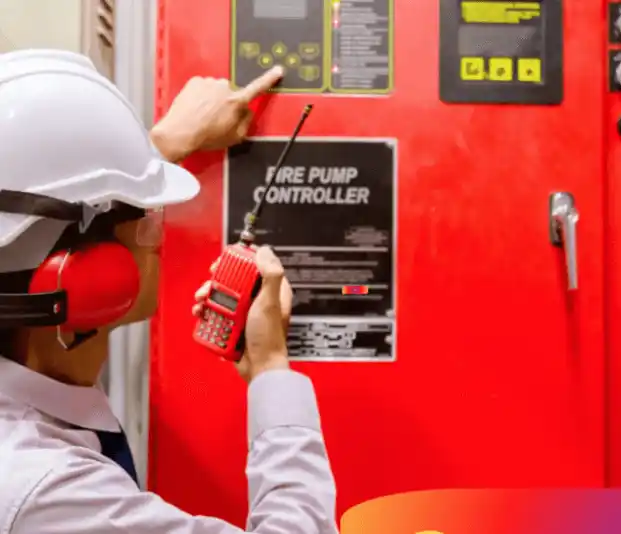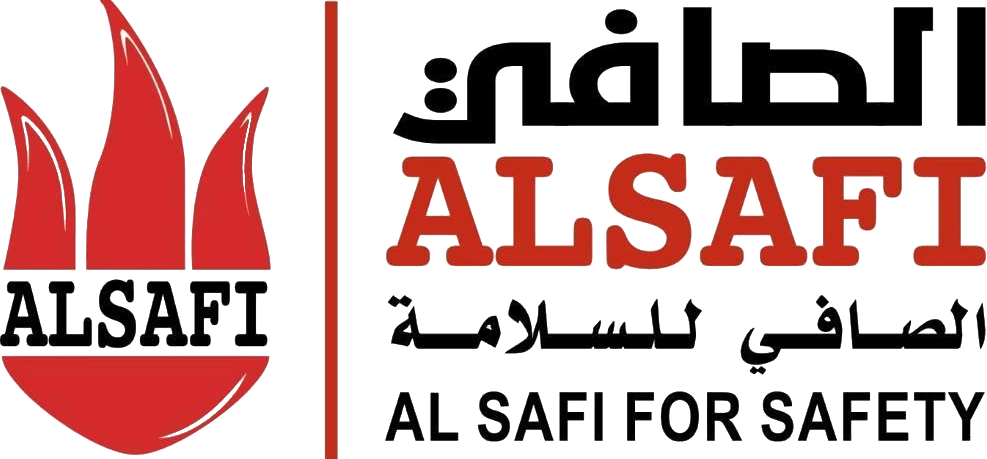المدونة
ما أهمية نظام إنذار الحريق في المنشآت؟

تخيل أن هُناك حريقًا يبدأ في صمت، دون أن يلاحظه أحد حتى يصبح خطرًا يهدد الجميع!
هنا تظهر أهمية وجود نظام إنذار الحريق في المنشآت كخط دفاع أول لحماية الأرواح والممتلكات؛ حيث يعتمد هذا النظام على أجهزة استشعار حديثة للكشف المبكر عن الحرائق، ويطلق تنبيهات فورية لتحذير الجميع من الخطر. في هذا المقال، سنستعرض مكونات هذا النظام، وأنواعه المُختلفة.
ما هي مكونات نظام إنذار الحريق؟
يتكون نظام إنذار الحريق في المنشآت من مجموعة من الأجهزة والتقنيات التي تعمل معًا للكشف عن الحرائق وتنبيه الأفراد، وتشمل المكونات الأساسية لهذا النظام ما يلي:
- أجهزة الكشف عن الحريق: مثل أجهزة كشف الدخان والحرارة.
- لوحة التحكم: هي وحدة التحكم الرئيسية التي تتلقى إشارات من أجهزة الكشف وتفعّل الإنذار.
- أجهزة إنذار الحريق: مثل جرس الإنذار أو صفارات الإنذار لتنبيه الجميع بوجود حريق.
- مصادر الطاقة: تشمل مصدر طاقة رئيسي وبطاريات احتياطية؛ لضمان استمرار عمل النظام في جميع الأوقات.
- الأزرار اليدوية: يمكن استخدامها لتفعيل الإنذار يدويًا في حالات الطوارئ.
أهمية نظام إنذار الحريق في المنشآت
نظام إنذار الحريق هو عنصر أساسي لا غنى عنه في أي منشأة؛ حيث يلعب دور محوري مُهم في تعزيز الأمان والاستجابة الفورية للطوارئ، كما أن وجود هذا النظام يحقق العديد من الفوائد الهامة؛ منها:
- تنبيه الأشخاص داخل المنشأة فور اكتشاف الحريق، مما يُمكنهم من الإخلاء بسرعة وأمان.
- الاكتشاف المبكر للحريق يتيح التدخل الفوري، مما يحد من حجم الأضرار والخسائر المحتملة.
- أنظمة إنذار الحريق شرط أساسي تفرضه معظم القوانين لضمان سلامة المنشآت والعاملين فيها؛ وبالتالي يُعد من متطلبات الامن والسلامة التي يجب الالتزام بها في المنشآت.
- وجود النظام يخلق بيئة مطمئنة للعاملين والزوار، مع التأكيد على أن المنشأة مجهزة للتعامل مع الطوارئ.
ما هو نظام الإنذار التلقائي؟
نظام الإنذار التلقائي هو نظام يعتمد على أجهزة حساسة للكشف عن الحريق، تعمل تلقائيًا عند اكتشاف أي علامات؛ مثل: (ارتفاع درجة الحرارة، أو تصاعد الدخان).
يتميز هذا النظام بسرعته ودقته؛ مما يساعد على تنبيه الجميع بشكل فوري وتقليل فرص انتشار الحريق قبل السيطرة عليه.
ما هو جرس إنذار الحريق؟
جرس إنذار الحريق هو أحد أهم مكونات نظام الإنذار؛ حيث يصدر صوت عالي؛ لتنبيه الأشخاص داخل المنشأة بوجود خطر.
يتوفر هذا الجرس بأشكال وأحجام متعددة تناسب طبيعة المباني وظروفها، مثل مستوى الضوضاء المحيط ويتم اختياره بعناية لضمان وضوح الصوت للجميع.
ما هي أنواع أنظمة الحريق؟
أنظمة الحريق تختلف بحسب طبيعة المنشأة واحتياجاتها، حيث صُمم كل نظام إنذار الحريق في المنشآت لتلبية متطلبات محددة وضمان الحماية الفعّالة؛ وتتمثل أشهر أنواع هذه الأنظمة فيما يلي:
النظام التقليدي:
يعتمد هذا النظام على تقسيم المنشأة إلى مناطق، ويُظهر موقع الحريق بشكل عام في لوحة التحكم؛ ولهذا يُعتبر مناسبًا للمباني الصغيرة والبسيطة التي لا تتطلب تحديد دقيق لموقع الحريق.
النظام المعنون (Addressable System):
يُستخدم في المنشآت الكبيرة والمعقدة؛ حيث يمكن تحديد موقع الحريق بدقة من خلال اجهزة الانذار المرتبطة بلوحة التحكم، ويتيح هذا النوع استجابة أسرع وأكثر كفاءة للطوارئ.
النظام اللاسلكي:
يعمل نظام إنذار الحريق في المنشآت اللاسلكي باستخدام تقنية الاتصال اللاسلكي، مما يُسهّل عملية التركيب ويُقلل من تكاليف الأسلاك؛ ولهذا يُناسب الأماكن التي يصعب فيها تمديد الكابلات؛ مثل: (المباني القديمة، أو المؤقتة).
أنظمة الإنذار الذكية:
هذه الأنظمة مزودة بتقنيات تحليل البيانات وبرمجيات متقدمة تقدم تقارير دقيقة عن حالة النظام والحوادث المحتملة، ويُعتبر هذا النوع مثالي للمباني الحديثة التي تتطلب مراقبة دقيقة واستباقية.
أنواع أجهزة إنذار الحريق
تتنوع اجهزة انذار الحريق حسب نوع الحريق الذي تكشف عنه وطبيعة المكان الذي تُستخدم فيه؛ وتتمثل هذه الأنواع فيما يلي:
- أجهزة كشف الدخان: تكتشف الدخان الناتج عن الحرائق في مراحلها الأولى.
- أجهزة كشف الحرارة: تعمل عند ارتفاع درجات الحرارة بشكل غير طبيعي.
- أجهزة كشف الغاز: تكتشف تسرب الغازات القابلة للاشتعال.
- أجهزة الإنذار متعددة الوظائف: تدمج بين كشف الدخان، الحرارة، والغاز.
كيف يعمل نظام إنذار الحريق؟
يعتمد نظام إنذار الحريق في المنشآت على آلية عمل مترابطة تبدأ برصد الخطر وتنتهي بتنبيه الأفراد؛ وتكون على النحو التالي:
- تُرسل أجهزة الكشف إشارات إلى لوحة التحكم عند اكتشاف دخان، حرارة، أو لهب.
- ثم تقوم لوحة التحكم بمراجعة الإشارات لتحديد مستوى الخطر.
- ويتم تفعيل أجهزة التنبيه الصوتية والبصرية لتحذير الموجودين في الموقع.
- ويُمكن ربط النظام بأنظمة أخرى مثل رشاشات المياه أو أجهزة الإطفاء التلقائي لضمان السيطرة على الحريق.
كيفية اختيار نظام إنذار الحريق المناسب؟
لاختيار النظام الأمثل، يجب مراعاة النقاط التالية:
- حجم المنشأة وطبيعة نشاطها: تختلف الاحتياجات بين المنازل، المصانع، أو المراكز التجارية.
- تقييم المخاطر: معرفة نوع الحرائق المحتملة في الموقع لتحديد الأجهزة المناسبة.
- الامتثال للمعايير: التأكد من أن النظام معتمد وفق اللوائح المحلية والدولية.
- الصيانة والدعم الفني: اختيار نظام يوفر سهولة الصيانة وخدمة ما بعد البيع، ويُفضل شراء النظام من خلال شركة سلامة معتمدة.
أفضل طريقة لشراء نظام إنذار الحريق المناسب لمنشأتك
اختيار نظام إنذار الحريق المناسب خطوة حاسمة لحماية الأرواح والممتلكات في منشأتك، وتُعد شركة الصافي لأنظمة الأمن والسلامة الخيار المثالي لتلبية احتياجاتك بأعلى معايير الجودة.
ولهذا نُقدم لك أهم الخطوات التي تُساعدك عند شراء نظام إنذار الحريق في المنشآت؛ والتي تتمثل فيما يلي:
- حدد طبيعة المنشأة (سكنية، تجارية، صناعية) ومتطلباتها لضمان اختيار النظام المناسب.
- اختر شركة رائدة في هذا المجال مثل الصافي للحصول على أنظمة معتمدة من الجهات الرسمية.
- اختيار النوع المناسب، مثل الأنظمة اليدوية، التلقائية، والمعنونة، لتلبية مختلف الاحتياجات.
- استفد من استشارات فريق الصافي لتحديد الحل الأنسب وفقًا لطبيعة منشأتك.
- تأكد من تركيب النظام باحترافية واستفد من خدمات الصيانة لضمان الأداء المستمر.
مع شركة الصافي، يمكنك الاعتماد على أنظمة إنذار حريق عالية الجودة، مصممة لتوفير أمان كامل وراحة بال. تواصل معنا الآن لبدء رحلة أمانك مع أفضل الحلول!
باختصار، نظام إنذار الحريق في المنشآت يُمثل العمود الفقري لأي استراتيجية سلامة داخل المنشآت؛ وذلك لدوره المهم على الكشف المبكر عن الحرائق وإطلاق التحذيرات في الوقت المناسب، يمكن إنقاذ الأرواح وتقليل الخسائر المادية بشكل كبير.
سواء كنت مسؤولًا عن منشأة سكنية، تجارية، أو صناعية، فإن الاستثمار في نظام إنذار حريق عالي الجودة مع الالتزام بالصيانة الدورية هو خطوة لا بد منها لضمان السلامة، ولأن الأمان لا يُقدر بثمن، اجعل نظام إنذار الحريق دائمًا في قائمة أولوياتك.
أسئلة شائعة قد تدور في ذهنك حول نظام إنذار الحريق في المنشآت
هل يجب صيانة نظام إنذار الحريق بانتظام؟
نعم، يُنصح بإجراء فحوصات دورية وصيانة منتظمة لضمان فعالية النظام واستجابته السريعة.
ما هي متطلبات تركيب نظام إنذار الحريق في المنشآت؟
تختلف المتطلبات حسب نوع المبنى واستخدامه، ويجب الالتزام بالمعايير واللوائح المحلية لضمان السلامة.
هل يمكن تركيب نظام إنذار الحريق في المنازل؟
نعم، يمكن تركيب أنظمة إنذار الحريق مخصصة للمنازل الصغيرة.
ما هي تكلفة تركيب نظام إنذار الحريق؟
تختلف التكلفة حسب حجم المنشأة ونوع النظام.
هل يمكن ربط نظام إنذار الحريق بأنظمة أخرى؟
نعم، يمكن ربطه بأنظمة الإطفاء التلقائي، أنظمة التحكم في الدخان، وأنظمة الإخلاء الصوتي لتعزيز السلامة.



